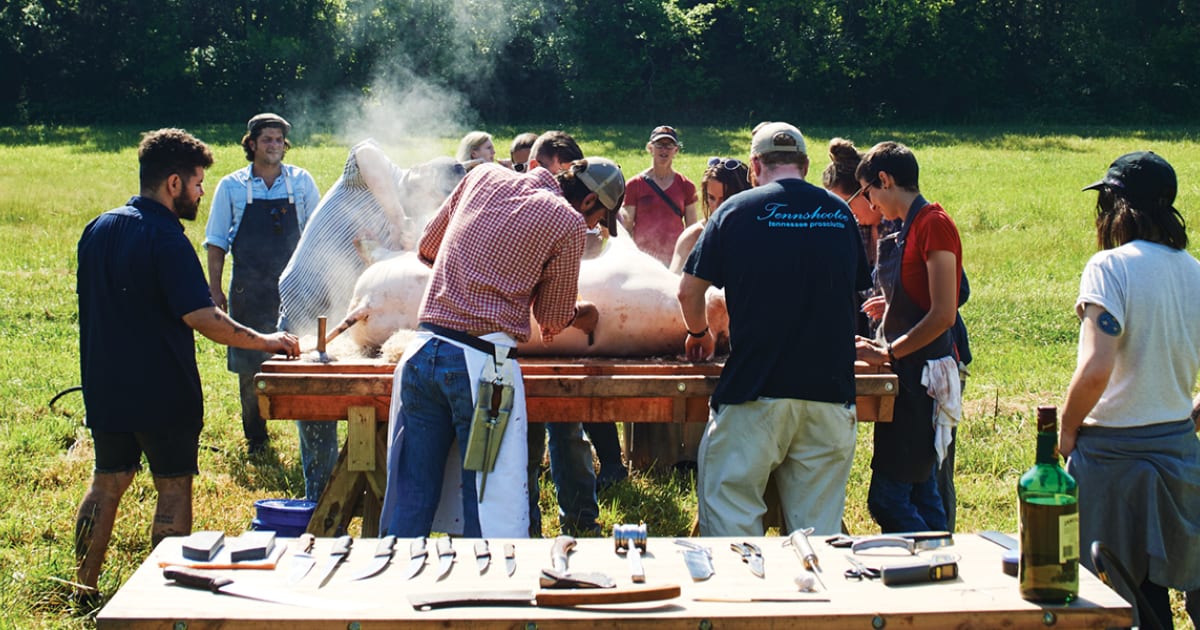TOBY RODRIGUEZ AND THE LÂCHE PAS TEAM ARE TOURING THE COUNTRY TO RESURRECT A CAJUN TRADITION
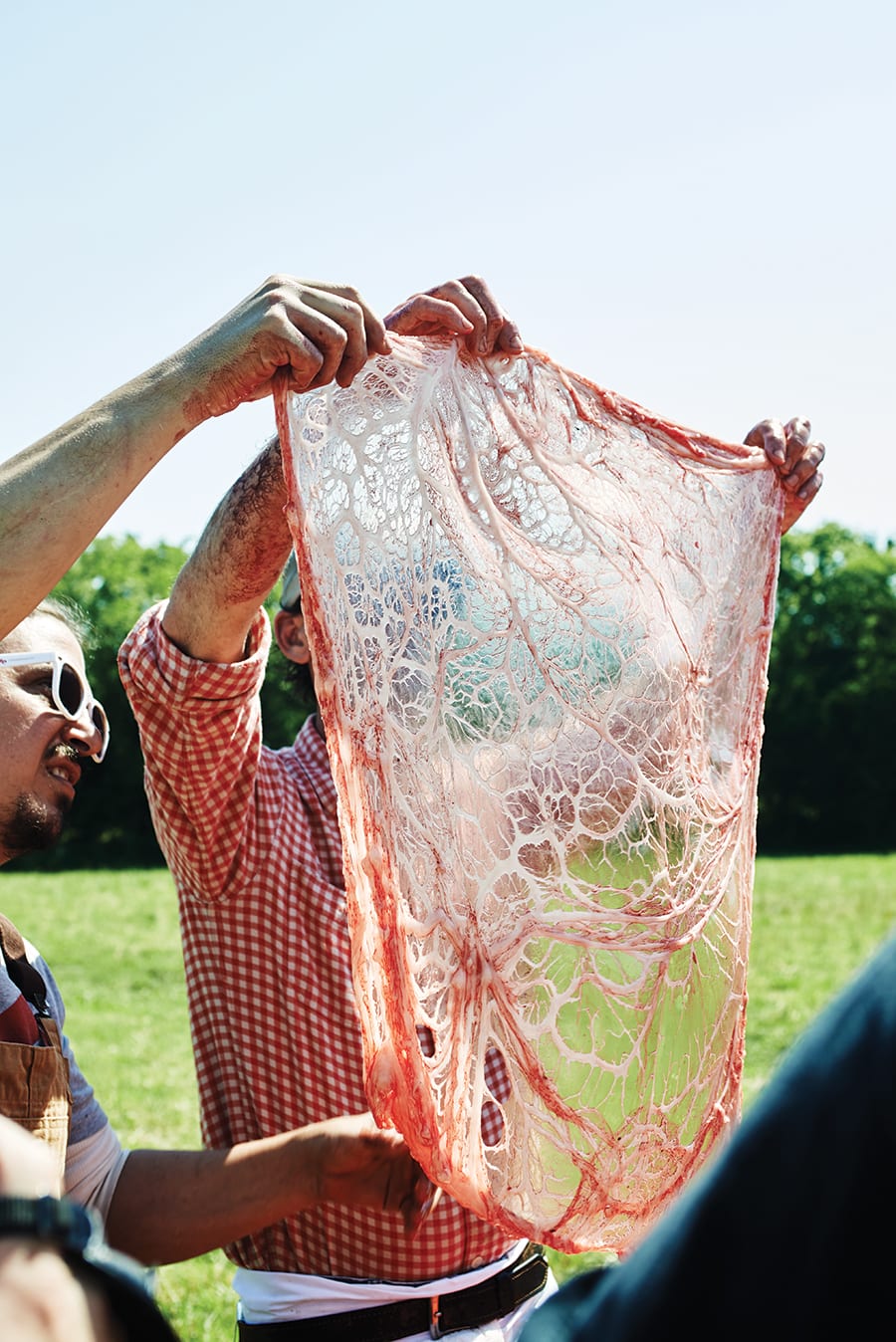
Back at the table, a tall, lanky man in an apron and worn trucker hat methodically pulls blades from a holster on his hip, giving each a once over and a wipe with a cloth before slipping it back in. Toby Rodriguez, chef, artist, and founder of Lâche Pas Boucherie et Cuisine—a Lafayette, Louisiana-based team that specializes in Cajun culinary heritage—is intent on the task at hand.
While Rodriguez works, Lâche Pas chef Chris McIntyre waves a wand of smoldering, smoking sage around him like an orchestra conductor, a rite both symbolic and sensible, meant to consecrate the occasion and cleanse the table surface of bacteria.
A little after 8 am, Lâche Pas members and a few men from the group of attendees and chefs lift the top of the table and carry it to a metal trailer in deep shade on the field’s edge. Rodriguez walks slowly behind them, his steps weighted with purpose. He disappears inside, while Overton’s mustached father says a short prayer, asking that all go well before offering thanks for the day’s beauty and the coming sacrifice.
While Rodriguez works, Lâche Pas chef Chris McIntyre waves a wand of smoldering, smoking sage around him like an orchestra conductor, a rite both symbolic and sensible, meant to consecrate the occasion and cleanse the table surface of bacteria.
A little after 8 am, Lâche Pas members and a few men from the group of attendees and chefs lift the top of the table and carry it to a metal trailer in deep shade on the field’s edge. Rodriguez walks slowly behind them, his steps weighted with purpose. He disappears inside, while Overton’s mustached father says a short prayer, asking that all go well before offering thanks for the day’s beauty and the coming sacrifice.
Lâche Pas means “don’t give up–never” and that relates to Acadian culture, the way it has held on and thrived all these years
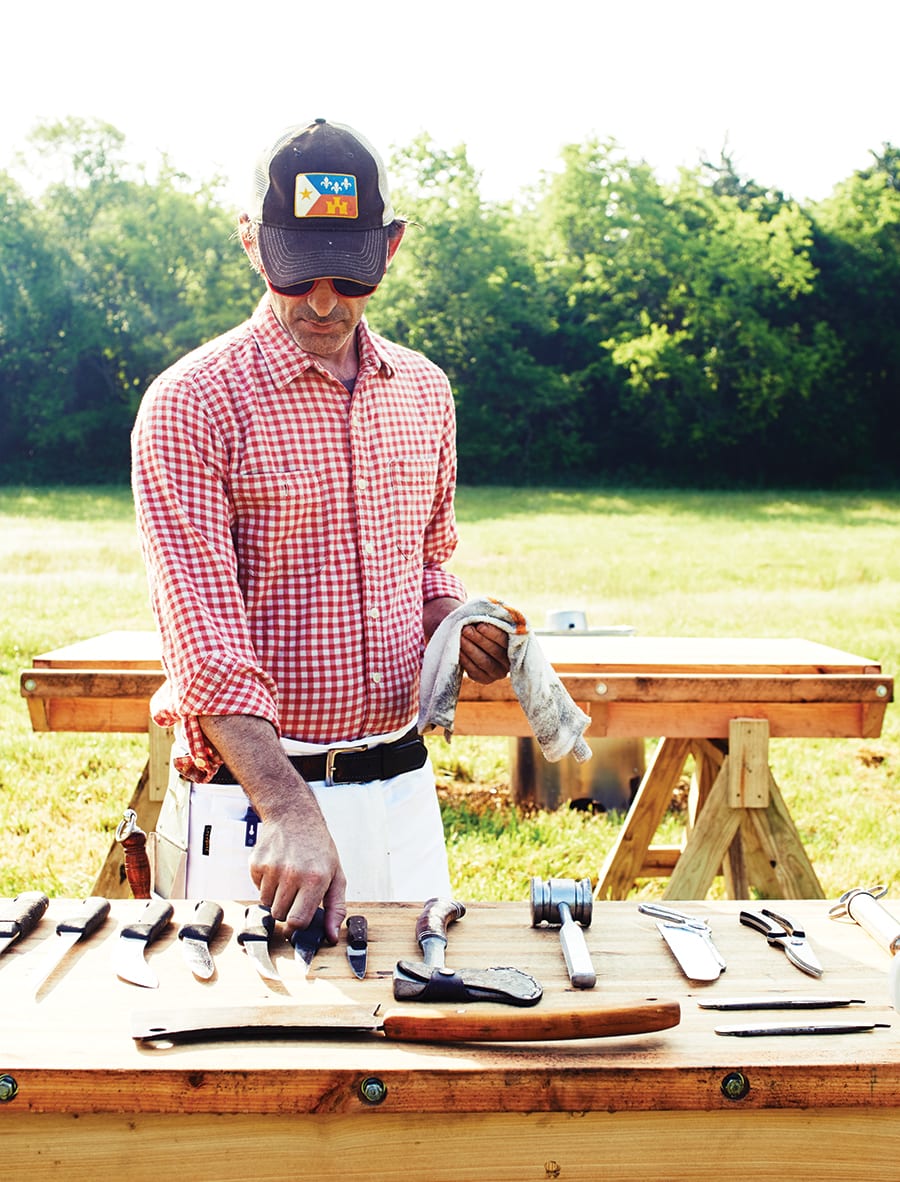
Rodriguez exits the trailer and places a bowl of food just outside its doors to draw the 300-pound Yorkshire hog inside into the open. In one fluid motion, he places the muzzle of a captive bolt gun against the animal’s head, and a muffled “thwack” breaks the silence. The stunned hog drops to its knees. Rodriguez’ quick, forceful thrust of a 16-inch scimitar blade slices the hog’s jugular and pierces the heart, finishing in seconds what the bolt to the brain started.
A few reflex kicks bang the side of the trailer, but the hog is gone. Rivulets of blood stream down the trailer’s lowered ramp; Lâche Pas chef Chanel Gaude catches as much of the still-hot liquid as she can in a large bowl and whisks it furiously with salt to halt coagulation. The hog is slid onto the tabletop, and the same men lift it and carefully carry the hog back to the table base, mute and respectful, like pallbearers at a funeral.
It’s bloody work, but not brutal. The initial shot ensures the hog isn’t aware of anything. Preventing fear and pain in the moments before and during its death is of the utmost importance to Rodriguez and his crew. It’s why he chose to work with Overton, known for her ethical treatment of the animals—hogs, ducks, geese, and chickens—she raises. “This hog was happy up until the instant he died,” she says.
At Rodriguez’ request, in the weeks leading up to the boucherie, she repeatedly placed an empty revolver on the hog’s temple and pulled the trigger. “It helped him get used to feel of cold steel and the sound,” she says, “and I hope it meant he was not afraid in the seconds before it happened.”
Some in the group are a bit shaken, and that’s okay with Rodriguez. The reverence he demands from boucherie attendees during the harvest—be on time, be quiet—makes it clear he’d be offended by anyone who took it lightly.
Cajun Crusader
Rodriguez has done boucheries in his hometown of Grand Coteau, Louisiana, for the last several years. He decided to take the show on the road and give folks far from Cajun country the opportunity to experience one. The two-year nationwide tour kicked off at Wedge Oak in May. Other stops have included St. Louis, Boulder, Santa Cruz, Seattle, and more with Atlanta and Birmingham still ahead and even Cuba on the calendar for 2017.
At each stop, local chefs and others in the food industry sign up to help butcher and cook the hog. The public is invited to buy tickets and attend as spectators and diners (although Rodriguez will put anybody who wants to help to work).
The two-day event starts solemnly with the harvest of the hog and end with a festive, pork-centric feast paired with wines and other libations. In between, the hog is butchered and broken down, and 90 percent of the animal ends up on the multi-course menu guests enjoy at dinner the second night.
The mission behind these gatherings, fueled by bourbon, boudin, and beer, goes beyond good food and fellowship; it’s Rodriguez’ goal that folks leave with a greater respect for the farmers who raise what we eat, and the humble animals who are what we eat, as well as the knowledge that we can take control of our food systems. “Our species does not have to depend on industry to feed itself,” Rodriguez says, his words quick, his accent, a mash-up of Cajun and Southern drawl, rounding his vowels and softening consonants. He spreads his arms wide. “This does not belong in a plant. We’ve lost our emotional connection to our food—that’s why we’re so wasteful. We need to get it back.”
Like a Cajun crusader, he’s committed to showing people how and why a return to roots is crucial, and he knows chefs can be influential ambassadors. “As the leaders in culinary communities, if they reconnect with food sources, then they’ll spread the message farther,” he says. He’s passionate, but not preachy. Quick with a joke (often a dirty one), he puts people at ease with humor and talks common sense. His idea that we should care about where our food comes from is not new. But getting close to your food when it has a heartbeat can be unsettling. Despite growing up on a farm where he saw and participated in boucheries routinely starting at age 10, Rodriguez still gets anxious.
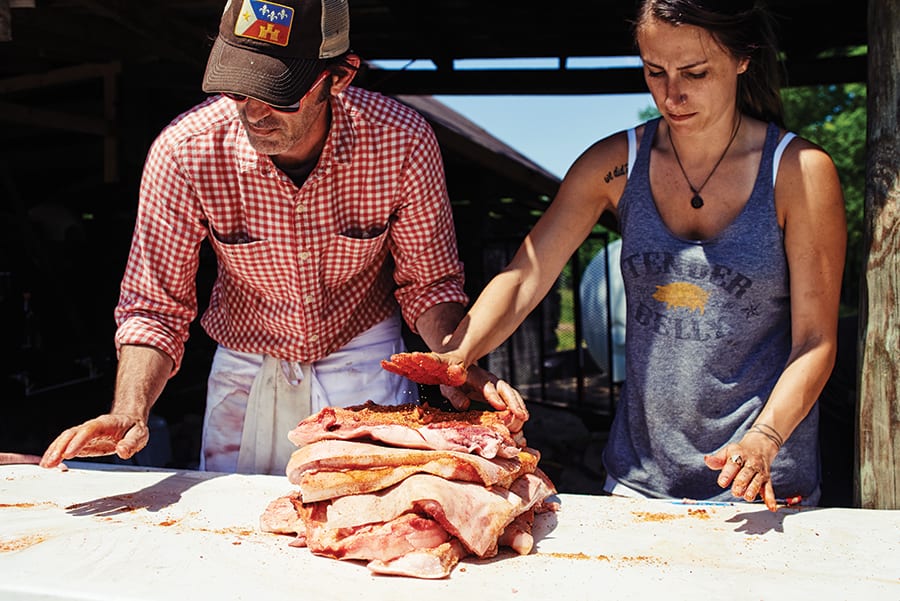
“I’m killing another creature; it’s intense. It’s not anything that I enjoy,” he says. He’s made a ritual of checking and cleaning his knives in the minutes before the harvest. “I put a lot of attention into getting my tools ready; it gets me out of my head a bit.”
But he’s never as tense as he was seven years ago, when someone asked him to do a boucherie after being away from the tradition for a time. After studying art at the University of Louisiana at Lafayette and a stint in the Army, he worked as a contractor, specializing in home renovations and carpentry. “I hadn’t done one in years, and I was nervous,” he says. “But as soon as the pig was on the table, it felt natural. I felt removed from everything around me. It’s the same feeling I get when drawing or sculpting.”
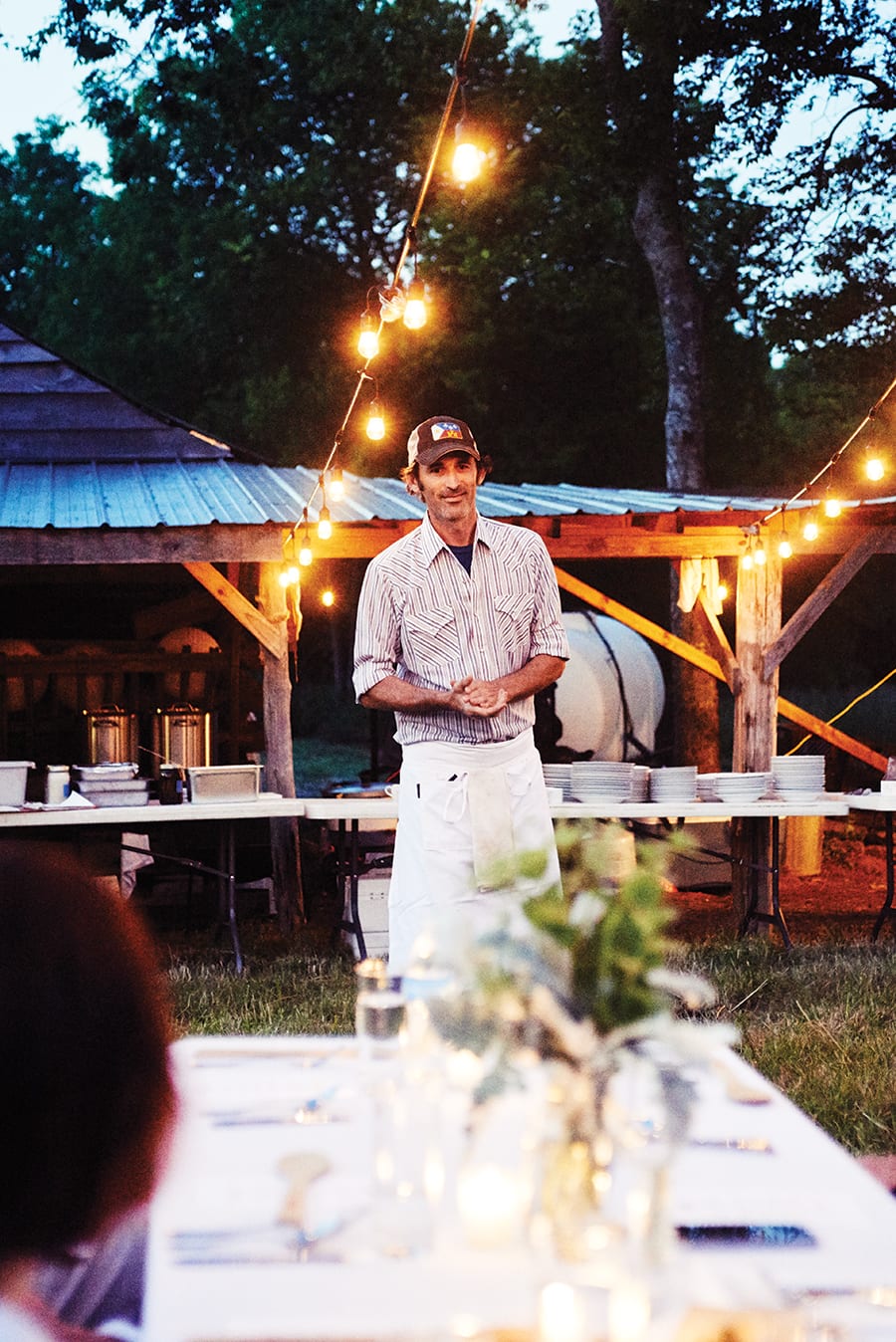
Beyond Boudin
The slaughter evokes powerful emotions that put a sharp point on Rodriguez’ message, but the butchering provides a practical education that lures chefs eager to learn new skills. “Proper butchering is such an integral thing for a chef,” says Jacob Wittenberg, a cook at Butcher & Bee in Nashville. “Plus, I think if you eat meat, you should be willing to see the death. It gives you increased appreciation for your food.”
As the group at Wedge Oak gathers around the hog for the first step, hair removal, the mood moves from somber to celebratory. “Pass this around—and remember, the best way to keep any hog hair from getting in is to keep a pair of lips around it,” Rodriguez says as he takes a swig from a bottle of whiskey and hands it off.
Some use dull-edged metal rings to scrape off the coarse hairs already loosened by a spray of scalding water. Braver souls gingerly wield knives. “Don’t cut the skin!” Rodriguez says, while expertly using a straight razor.
Once the hog is smooth, Rodriguez turns teacher, flipping the hog on its back and splitting it open with one long slit. He works with surgical precision and explains every slice. He instructs others where to cut, how, and why. He holds up a hunk off the backbone. “Look how pretty that is! Brought to you by Karen and God,” he says. The meat, along with most of the organs, goes into coolers marked with names of the dishes they’ll be used in.
Lâche Pas chef Barrett Dupuis gets busy grinding shoulder and rib meat for boudin. Some of it is for boudin noir, a version of the staple sausage that owes its color and rich flavor to the addition of the blood that Gaude collected. “Boudin is definitely my favorite to make and to eat,” Dupuis says. “It’s such a major player in Cajun cuisine.”
McIntyre gathers ropes of Dupuis’ boudin links and hangs them in Wolfgang von Sausage, the cold smoker designed and built by the Lâche Pas team. He continually feeds Wolfgang coals from Big Sexy, a Lâche Pas-designed furnace surrounded by a quivering wall of vicious heat that renders oak into ash-white embers in less than thirty minutes.
Preserving Culture
Sausage-making is only one of the crafts the team is keeping alive. Boucheries were originally a necessary form of meat preservation, but Lâche Pas boucheries are about preserving culture. “Boucheries have never really been documented,” Rodriguez says. “We’re chronicling these old techniques; it may be the first time some of them have been written down.”
The culmination of the group’s labor, the “Lundi Soir” dinner the second night, imprints the flavors of Acadia in the guests’ memories. White-clothed tables are lined up in the field a few yards from the kitchen, under stars and strings of glowing bare bulbs. Rodriguez welcomes diners who are already digging into the first course—boudin boulette, an orb of boudin and rice stuffed with creamy, salty camembert, crusted in cornmeal and fried, then glazed with cayenne-laced honey. “Thanks for being here, y’all. We’re here to show you why the origins of what you eat matter and to share our story,” he says. “Lâche Pas means ‘don’t give up—never’ and that relates to Acadian culture, the way it has held on and thrived all these years.” Five more courses follow, including a sweet and savory dessert incorporating cracklins and figs steeped in cane vinegar.
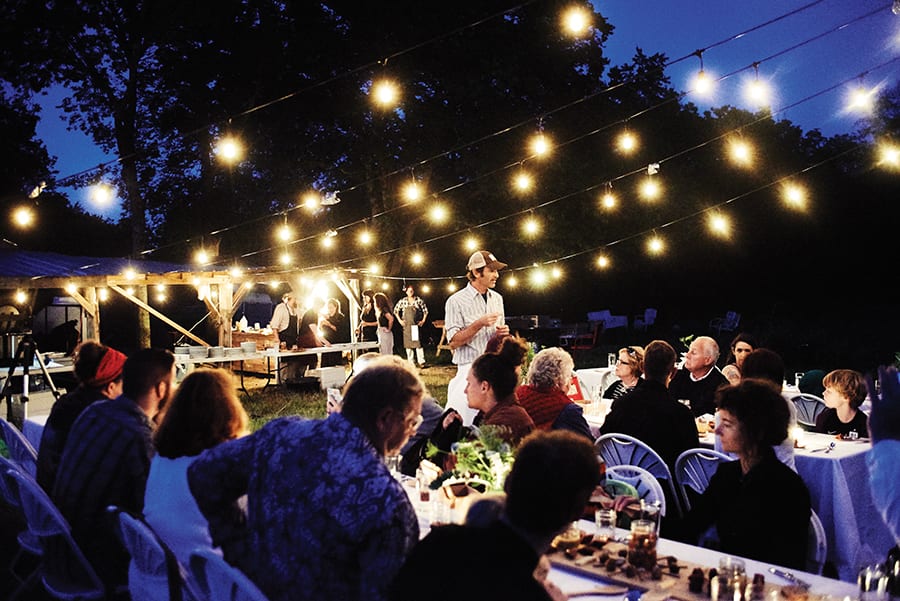
Rodriguez’ favorite marked the middle of the meal. “I love the fraisseurs, also called butcher’s stew,” he says. The thick brown medley of various parts—heart, tongue, kidney, and tenderloin—slow simmered to melt the ingredients together, yet let them retain a hint of their distinction, is a fitting metaphor for a boucherie: It’s a history lesson, it’s a cooking class, it’s art, it’s a party, all imbued with a higher purpose. It’s just as applicable to Lâche Pas’ goals and methods–to revive tradition, celebrate life by honoring death, and use the community and camaraderie that surrounds food to create something meaningful.
This story originally appeared in the October 2016 issue.
share
in this article
-
Exploring Mississippi: A Quintessential Southern Experience
-
Recipes From Our Summer Issue
by TLP Editors -
Elevate Your AWESOME with an Alpharetta Music Getaway
by TLP's Partners -
9 Noteworthy Tennessee Restaurants | Listen
by Margaret Littman -
Outdoor Adventure and Historic Charm Awaits in St. Martin Parish
by TLP's Partners
more from At the Table
-
High Tea, Southern Style
-
10 Leftover Recipes To Clean Out Your Fridge
-
Country Captain Shrimp and Grits
-
10 Nonalcoholic Drinks for Dry January
-
Our Most Popular Recipes of 2023





